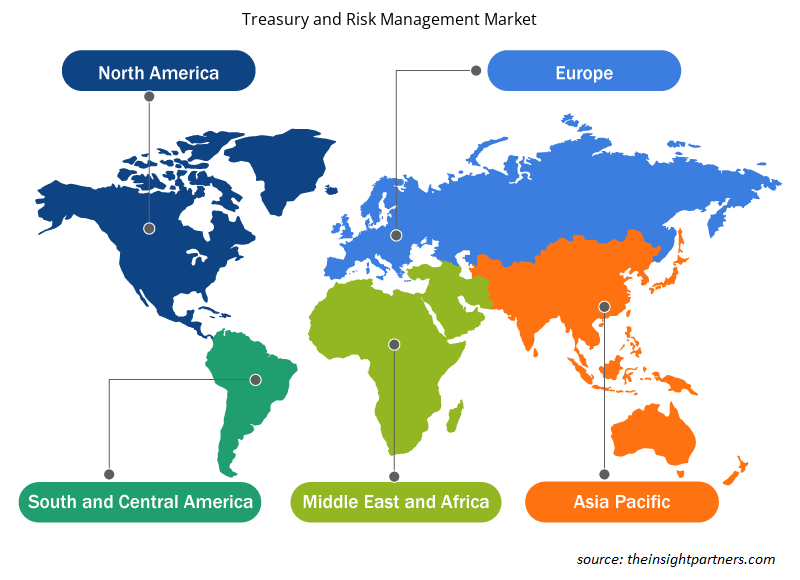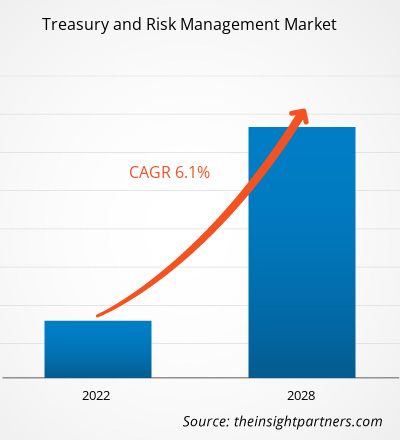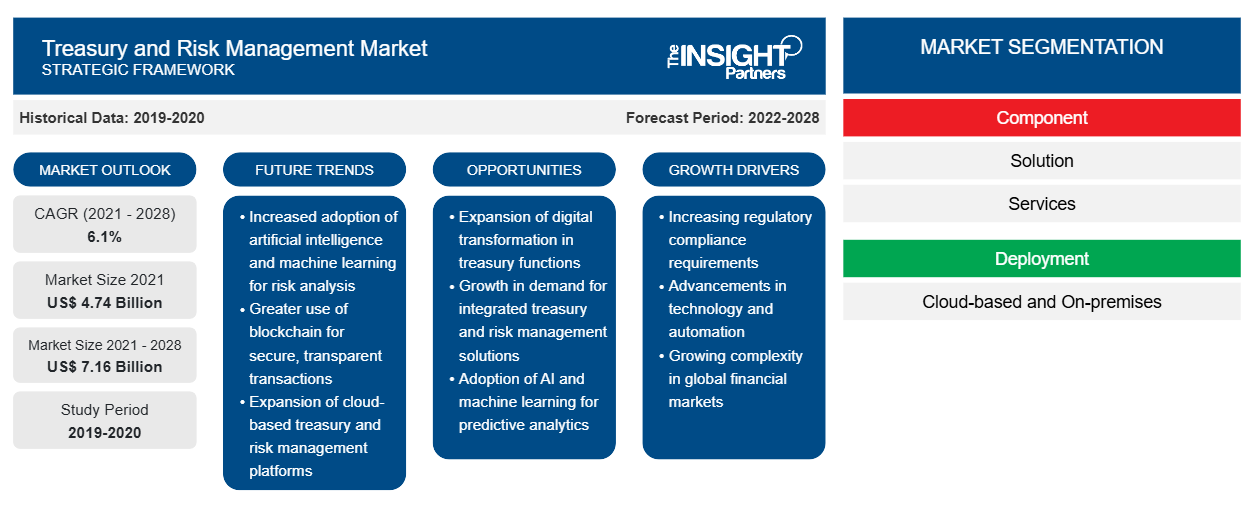من المتوقع أن ينمو سوق الخزانة وإدارة المخاطر من 4,739.39 مليون دولار أمريكي في عام 2021 إلى 7,156.90 مليون دولار أمريكي بحلول عام 2028؛ ومن المتوقع أن ينمو بمعدل نمو سنوي مركب قدره 6.1٪ خلال الفترة 2021-2028.
يساعد الذكاء الاصطناعي (AI) صناعة التمويل على تبسيط وتحسين العمليات المختلفة، بدءًا من قرارات الائتمان إلى التحليل الكمي في إدارة المخاطر المالية والخزينة . تسهل حلول الذكاء الاصطناعي تقييمات أكثر دقة للمقترضين المحرومين تقليديًا، بما في ذلك جيل الألفية، في عملية اتخاذ القرارات الائتمانية، وبالتالي، تساعد البنوك ومقرضي الائتمان على اتخاذ قرارات تجارية أكثر ذكاءً. علاوة على ذلك، يعمل الذكاء الاصطناعي على تسهيل عملية التمويل وأتمتتها في العديد من البنوك وشركات الاستثمار وشركات إدارة الثروات. على سبيل المثال، تستخدم شركة aixigo AG حلول إدارة الثروات القائمة على الذكاء الاصطناعي لتوفير التحول الرقمي والخدمات المصرفية الخاصة والخدمات المصرفية للأفراد والمستشارين الآليين وخدمات إدارة الأصول. يستخدم برنامج المستشار الآلي لشركة aixigo AG الذكاء الاصطناعي لاستبدال المكونات البشرية في نقطة البيع أثناء عملية الاستثمار المالي. وبالمثل، تقدم شركة Synechron Inc. حلاً قائمًا على الذكاء الاصطناعي يسمى Neo لصناعة الخدمات المالية. يجمع Neo بشكل فريد بين الاستشارات الرقمية والتجارية والتكنولوجية لشركة Synechron لتوجيه المؤسسات المالية من خلال نشر حلول الذكاء الاصطناعي للتغلب على تحديات الأعمال المعقدة. لذلك، من المتوقع أن يؤدي الارتفاع في شعبية المساعدة القائمة على الذكاء الاصطناعي في البنوك وشركات الاستثمار وشركات إدارة الثروات إلى دفع حصة سوق الخزانة وإدارة المخاطر خلال الفترة المتوقعة.
قم بتخصيص هذا التقرير ليناسب متطلباتك
ستحصل على تخصيص لأي تقرير - مجانًا - بما في ذلك أجزاء من هذا التقرير، أو تحليل على مستوى الدولة، وحزمة بيانات Excel، بالإضافة إلى الاستفادة من العروض والخصومات الرائعة للشركات الناشئة والجامعات
- احصل على أهم اتجاهات السوق الرئيسية لهذا التقرير.ستتضمن هذه العينة المجانية تحليلاً للبيانات، بدءًا من اتجاهات السوق وحتى التقديرات والتوقعات.
تأثير جائحة كوفيد-19 على سوق الخزانة وإدارة المخاطر العالمية
قبل جائحة كوفيد-19، كان الطلب على حلول/خدمات إدارة الخزانة والمخاطر سائدًا بسبب الرقمنة المتنامية. على سبيل المثال، في أبريل 2019، وفقًا للمقال الذي نشرته بيزنس واير، بلغ الإنفاق على التحول الرقمي 1.18 تريليون دولار أمريكي في عام 2019، بزيادة قدرها 17.9% عن عام 2018.
وفقًا لتحليل سوق الخزانة وإدارة المخاطر، في عام 2020، أثر جائحة كوفيد-19 بشكل ملحوظ على عمليات الشركات وغير بعض الجوانب الأساسية للأعمال. أدى انتشار كوفيد-19 في عام 2020 إلى عمليات إغلاق عالمية في العديد من البلدان لتجنب الأزمة وتقليل مخاطر الإصابة. وقد أدى هذا إلى طفرة كبيرة في تبني التقنيات الرقمية لإبقاء الشركات تعمل أثناء تفشي كوفيد-19. تحولت معظم الشركات إلى البنية التحتية السحابية واستمرت في عملياتها مع الحفاظ على قيود الإغلاق. علاوة على ذلك، دفع جائحة كوفيد-19 الشركات إلى التفكير في مستقبل الخزانة المؤسسية بما يتماشى مع الرقمنة وإدارة المخاطر المتكاملة والتركيز المتجدد على تحسين التكلفة وإدارة النقد. وبالتالي، شهد اعتماد حلول/خدمات الخزانة وإدارة المخاطر ارتفاعًا في عام 2020. لذلك، كان التأثير الإجمالي لجائحة كوفيد-19 على سوق الخزانة وإدارة المخاطر إيجابيًا في عام 2020.
وفقًا لتحليل سوق إدارة الخزانة والمخاطر في عامي 2021 و2022، فإن تخفيف إجراءات الإغلاق، وتبني تقنيات الحوسبة السحابية من قبل العديد من الشركات، وانتقال المنظمات نحو الأتمتة باستخدام تقنيات مثل الذكاء الاصطناعي والتعلم الآلي لإدارة النقد، كان لها تأثير إيجابي على نمو سوق إدارة الخزانة والمخاطر. على سبيل المثال، في مايو 2021، أعلنت شركة Refinitiv وIBSFINtech عن تعاون لإطلاق حل جديد لإدارة الخزانة الآلية قائم على السحابة. سيكون الحل المسمى InTReaX حلاً لإدارة النقد والسيولة ومخاطر العملة. وبالتالي، فإن اعتماد حلول إدارة الخزانة القائمة على السحابة من قبل العديد من الشركات سيخلق فرصًا متعددة للاعبين في السوق.
بلغ حجم سوق إدارة الخزانة والمخاطر قبل جائحة كوفيد-19 نحو 4,337.46 مليون دولار أمريكي في عام 2019. وبلغ حجم السوق أثناء الجائحة نحو 4,526.57 مليون دولار أمريكي في عام 2020. وعلاوة على ذلك، بلغ حجم السوق في عام 2021 نحو 4,739.39 مليون دولار أمريكي. وبالتالي، كان التأثير الإجمالي لجائحة كوفيد-19 على السوق إيجابيًا في عام 2020.
رؤى حول سوق الخزانة وإدارة المخاطر
تزايد الطلب على خدمات التحليلات المالية
تستخدم المؤسسات أدوات التحليلات المالية للحصول على رؤى حول بعض الاتجاهات الحالية والمستقبلية لتحسين أداء أعمالها. تقدم خدمات التحليلات المالية تحليل جودة البيانات المالية، وتخطيط البيانات، وتحليلات العملاء، والتحليلات التنبؤية، وتحليل المكونات الرئيسية، وجمع البيانات المالية. تتطلب هذه التحليلات بيانات مالية مفصلة وبيانات أخرى ذات صلة لتحديد الأنماط. بناءً على هذا التحليل، تقوم المؤسسات بإجراء تنبؤات بشأن مشتريات عملائها وفترة عمل موظفيها. وبالتالي، تساعد خدمات التحليلات المالية المؤسسات على تحسين الربحية والتدفق النقدي وقيمة الأعمال. يمكنهم استخدام الرؤى المكتسبة من خلال هذه التحليلات لتحسين إيراداتهم وعملياتهم التجارية. على سبيل المثال، توفر شركة أكسنتشر بي إل سي أحدث حلول البيانات والتحليلات لمقدمي الخدمات المالية وتساعدهم في نشرها. يتضمن تحليل تقرير الخزانة وإدارة المخاطر خدمات لهذه الشركات مع تحليلات التكلفة وتحليلات أداء المؤسسة. مع التركيز الأساسي على بيانات الدخل والميزانيات العمومية وبيانات التدفق النقدي، يتم استخدام التحليل المالي لتقييم الاتجاهات الاقتصادية، ووضع السياسات المالية، وصياغة خطط الأعمال طويلة الأجل، وتحديد المشاريع أو الشركات للاستثمار. يقوم مقدمو الخدمات المالية مثل البنوك الاستثمارية بتوليد وتخزين المزيد من البيانات مقارنة بالشركات الأخرى، حيث أن التمويل هو عمل يعتمد على المعاملات بشكل كبير. تستخدم البنوك البيانات لتقدير المخاطر لتحسين الربحية الإجمالية. وبالتالي، مع الفوائد المتعددة في البنوك وشركات الاستثمار، يتزايد الطلب على خدمات التحليلات المالية بشكل كبير، وبالتالي تعزيز نمو سوق الخزانة وإدارة المخاطر.
إن وظائف الخزانة هي المستفيدة الواضحة من التحليلات المالية، والتي توفر رؤى أفضل للعملاء والمنافسين والربحية والعمليات. كما يمكن للتحليلات المالية أن تعزز قدرة المدير المالي على قيادة عملية اتخاذ القرار الاستراتيجي والتخطيط للاستثمار. وبالتالي، أصبح إنشاء منظمة مدفوعة بالتحليلات أيضًا المحرك الرئيسي للتعاون بين المدير المالي والمدير التنفيذي للمعلومات. وبالتالي، فإن الطلب على خدمات التحليلات المالية ينمو بشكل كبير، مما يدفع سوق الخزانة وإدارة المخاطر.
رؤى السوق القائمة على المكونات
بناءً على المكون، ينقسم سوق إدارة الخزانة والمخاطر إلى الحلول والخدمات. وقد تصدر قطاع الحلول السوق بحصة أكبر في عام 2020.
رؤى السوق القائمة على النشر
بناءً على النشر، ينقسم سوق إدارة الخزانة والمخاطر إلى سوق قائم على السحابة وسوق محلي. وقد قاد قطاع السحابة السوق بحصة أكبر في عام 2020.
رؤى السوق بناءً على حجم المؤسسة
بناءً على حجم المؤسسة، ينقسم سوق إدارة الخزانة والمخاطر إلى شركات صغيرة ومتوسطة الحجم وشركات كبيرة. وقد تصدرت شريحة الشركات الكبيرة السوق بحصة أكبر في عام 2020.
رؤى السوق القائمة على التطبيقات
بناءً على التطبيق، يتم تقسيم سوق إدارة الخزانة والمخاطر إلى إدارة الحسابات، وإدارة النقد والسيولة، والامتثال وإدارة المخاطر، وإدارة الموارد المالية. استحوذ قطاع إدارة النقد والسيولة على أكبر حصة سوقية في عام 2020.
رؤى السوق المستندة إلى المستخدم النهائي
بناءً على المستخدم النهائي، يتم تقسيم السوق إلى BFSI، وIT & telecom، و Retail & ecommerce، و Healthcare، و Manufacturing & cars، وغيرها. قاد قطاع BFSI سوق الخزانة وإدارة المخاطر بأكبر حصة في عام 2020.
يتبنى اللاعبون العاملون في سوق الخزانة وإدارة المخاطر استراتيجيات مثل عمليات الدمج والاستحواذ والمبادرات السوقية للحفاظ على مواقعهم في السوق. وفيما يلي قائمة ببعض التطورات التي قام بها اللاعبون الرئيسيون:
- في يوليو 2021، أطلقت FIS سلسلة جديدة من حلول إدارة المخاطر المدعومة بالذكاء الاصطناعي. أعلنت FIS عن مجموعة جديدة من المنتجات التي تم إنشاؤها بالتعاون مع C3 AI لمساعدة مؤسسات أسواق رأس المال في إدارة الامتثال التنظيمي والمخاطر بشكل أفضل باستخدام قوة بياناتها التنظيمية.
- في نوفمبر 2020، اختار بنك Lunar، وهو بنك منافس في دول الشمال الأوروبي، حل FIS القائم على السحابة في قطاع إدارة الخزانة والمخاطر بهدف الحصول على الدعم في تحسين السيولة وإدارة المخاطر والتوسع. اختار Lunar نظام Ambit Quantum السحابي الخاص من FIS لتبسيط المحاسبة التحوطية والامتثال التنظيمي. يستخدم Lunar مكتب خدمة SWIFT التابع لـ FIS لربط عمليات الخزانة والدفع الخاصة به بالشركاء المصرفيين من خلال SWIFT وغيرها من البورصات والشبكات الصناعية.
رؤى إقليمية حول سوق الخزانة وإدارة المخاطر
لقد قام المحللون في Insight Partners بشرح الاتجاهات والعوامل الإقليمية المؤثرة على سوق الخزانة وإدارة المخاطر طوال فترة التوقعات بشكل شامل. يناقش هذا القسم أيضًا قطاعات سوق الخزانة وإدارة المخاطر والجغرافيا في جميع أنحاء أمريكا الشمالية وأوروبا ومنطقة آسيا والمحيط الهادئ والشرق الأوسط وأفريقيا وأمريكا الجنوبية والوسطى.

- احصل على البيانات الإقليمية المحددة لسوق الخزانة وإدارة المخاطر
نطاق تقرير سوق الخزانة وإدارة المخاطر
| سمة التقرير | تفاصيل |
|---|---|
| حجم السوق في عام 2021 | 4.74 مليار دولار أمريكي |
| حجم السوق بحلول عام 2028 | 7.16 مليار دولار أمريكي |
| معدل النمو السنوي المركب العالمي (2021 - 2028) | 6.1% |
| البيانات التاريخية | 2019-2020 |
| فترة التنبؤ | 2022-2028 |
| القطاعات المغطاة | حسب المكون
|
| المناطق والدول المغطاة | أمريكا الشمالية
|
| قادة السوق وملفات تعريف الشركات الرئيسية |
|
كثافة اللاعبين في السوق: فهم تأثيرها على ديناميكيات الأعمال
يشهد سوق إدارة الخزانة والمخاطر نموًا سريعًا، مدفوعًا بالطلب المتزايد من المستخدم النهائي بسبب عوامل مثل تفضيلات المستهلكين المتطورة والتقدم التكنولوجي والوعي المتزايد بفوائد المنتج. ومع ارتفاع الطلب، تعمل الشركات على توسيع عروضها والابتكار لتلبية احتياجات المستهلكين والاستفادة من الاتجاهات الناشئة، مما يؤدي إلى زيادة نمو السوق.
تشير كثافة اللاعبين في السوق إلى توزيع الشركات أو المؤسسات العاملة في سوق أو صناعة معينة. وهي تشير إلى عدد المنافسين (اللاعبين في السوق) الموجودين في مساحة سوق معينة نسبة إلى حجمها أو قيمتها السوقية الإجمالية.
الشركات الرئيسية العاملة في سوق الخزانة وإدارة المخاطر هي:
- شركة برودريدج للحلول المالية
- الاتحاد الدولي للتزلج على الجليد
- شركة أوراكل
- برايس ووتر هاوس كوبرز الدولية المحدودة (PWC)
- ساب اس اي
إخلاء المسؤولية : الشركات المذكورة أعلاه ليست مرتبة بأي ترتيب معين.

- احصل على نظرة عامة على أهم اللاعبين الرئيسيين في سوق الخزانة وإدارة المخاطر
نبذة عن الشركة
- شركة برودريدج للحلول المالية
- الاتحاد الدولي للتزلج على الجليد
- شركة أوراكل
- برايس ووتر هاوس كوبرز الدولية المحدودة (PWC)
- ساب اس اي
- شركة فيسيرف
- شركة كاليبسو للتكنولوجيا (أدينزا)
- شركة كيريبا
- مورس للبرمجيات
- وولترز كلوير
- التحليل التاريخي (سنتان)، سنة الأساس، التوقعات (7 سنوات) مع معدل النمو السنوي المركب
- تحليل PEST و SWOT
- حجم السوق والقيمة / الحجم - عالمي، إقليمي، بلد
- الصناعة والمنافسة
- مجموعة بيانات إكسل
التقارير الحديثة
تقارير ذات صلة
شهادات العملاء
سبب الشراء
- اتخاذ قرارات مدروسة
- فهم ديناميكيات السوق
- تحليل المنافسة
- رؤى العملاء
- توقعات السوق
- تخفيف المخاطر
- التخطيط الاستراتيجي
- مبررات الاستثمار
- تحديد الأسواق الناشئة
- تحسين استراتيجيات التسويق
- تعزيز الكفاءة التشغيلية
- مواكبة التوجهات التنظيمية





















 احصل على عينة مجانية ل - سوق الخزانة وإدارة المخاطر
احصل على عينة مجانية ل - سوق الخزانة وإدارة المخاطر